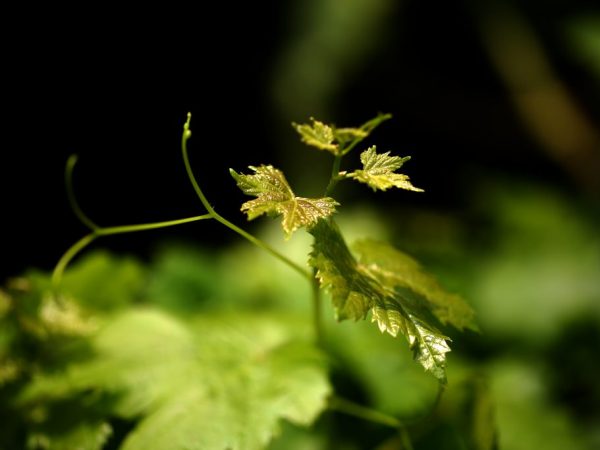Growing grapes Elegant
Many do not dare to grow grapes on their plots, because it needs long-term and high-quality care. Especially for those who want to eat delicious berries and spend a minimum amount of time growing, breeders have bred Elegant grapes.

Growing grapes Elegant
Variety characteristic
Grape variety Elegant, very early, characterized by resistance to most diseases. The growing season of this variety is only 100 days - the harvest falls at the beginning of August. The variety is self-pollinated, therefore it does not need other, adjacent species planted nearby. The plant begins to bear fruit in 3 years after planting in a permanent place.
The description indicates that it can withstand frosts down to -30 ° C, so gardeners do not need to cover the bushes with agrofibre or mulch the soil in the fall. Elegant grapes give a stable yield: 20-25 kg per bush.
Features of the tree
The plant is undersized, 2 m high. The vine is thin and fragile. Leaves are medium in size. The length of the leaf plate is 5 cm, and the width is 3 cm. There is a small waxy coating and small stripes on the surface of the leaf. The color of the leaves is dark green, wrinkled.
Fruit type
Description of the Elegant grape:
- large berry, weight 30 g;
- the peel is of a pleasant creamy shade, almost transparent;
- the shape of the fruit is ovoid;
- the berries form a cone-shaped bunch, the weight of which is 700 g.
The taste of the fruit is pleasant, sweet, without acid or bitterness. The pulp is juicy. Muscat aroma prevails. Suitable for making pleasant wines, desserts and fresh consumption.
Growing rules
The very early elegant grape belongs to the heat-loving crops, the choice of the place is treated with special care.
- Choose sunny areas where there are no plants or buildings to shade the crop. It is better to grow from the southern part of the garden, because in this place the most abundant sun rays, which will accelerate the process of fruit ripening.
- Give preference to elevated areas that will not allow groundwater to disrupt the development of the root system, and the entire plant as a whole. The minimum depth of groundwater should be 2 m.
Choose light loamy soils for planting that are rich in nutrients. If this is not possible, add lime to the soil (3 kg / m²). This has a positive effect on the nutritional value of the soil and accelerates the process of plant acclimatization. Lime will help speed up the growth of the bush and the formation of bunches.
Landing features

A young plant needs to be tied up
It is better to start planting in October or April. At this time, the frosts are not so severe. For planting, young seedlings are used, which were grown in containers. Planting is carried out in these containers so as not to deform the roots. The seedling should be 1-2 years old. It should show the place where the vaccination was made. There should be no traces of diseases or damaged areas on the planting material.
Prepare a hole for planting.The depth is 40X50 cm. Humus and peat are poured onto the bottom (1: 1). For maximum protection against root rot, a gravel drainage system is installed.
A seedling is placed inside the planting pit and the roots are leveled over the entire area. The root collar should be located above the ground. The roots are carefully sprinkled with the top layer of soil. A support is installed nearby, which will protect the weak vine from windy weather and deformation.
The distance between the bushes should be 2 m, and between the rows 3 m.
Care activities
Only warm water should be used for irrigation. It will improve the adhesion of the root system to the ground. The grapes do not need frequent watering, so the interval should be 20 days. Water is poured into a special trench, which is made around the seedling. Its depth should be 20-30 cm.
Top dressing should be carried out as the plant develops. The first fertilization is carried out 3 years after planting. At this time, the bushes are fed with potassium nitrate (20 g per 10 l of water). In summer, it is better to add superphosphate (50 g per 10 l of water), which will improve the yield.
Pruning is done in early summer. At this time, shoots are removed and no more than 5 eyes should remain. The tendrils and weakened vines are removed.
Pest and disease control
Elegant grapes are affected by fruit rot or olive spot.
- A solution of Bordeaux liquid (2 g per 5 liters of water) will help fight fruit rot.
- A tincture of wood ash will allow you to get rid of olive spotting (300 g is dissolved in 10 liters of water and infused for 3 days). Spraying should be done at intervals of 10 days
Among the pests, scoops, aphids, ticks and beetles are noted. To get rid of the scoop, use a solution of Ridomir (10 g per 5 l of water). In the fight against aphids, a copper-containing preparation Oxyhom is used (40 g per 10 liters of water). A measure of the fight against ticks will be the Quadris solution (20 g per 5 liters of water). Acrobat (50 g per 10 liters of water) will help save the crop from beetles.
Conclusion
The description indicates that this species is very early, it is unpretentious to care for. If you grow Elegant Grapes according to all the rules, it will strengthen its immune system and protect against many diseases. Planting and care rules affect the further development of the bushes.


